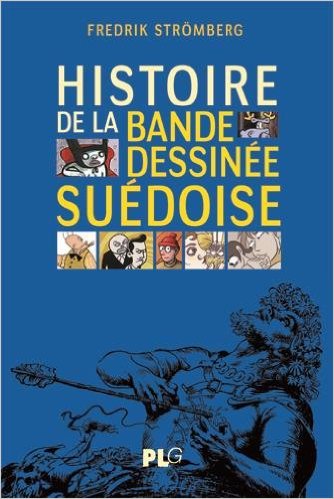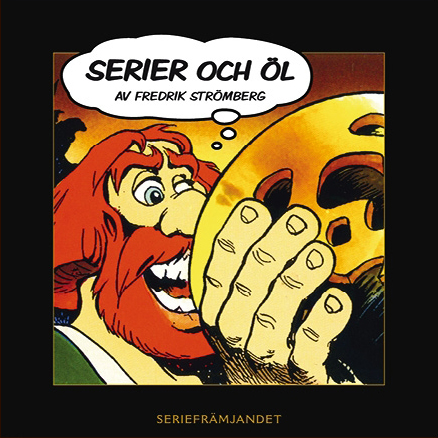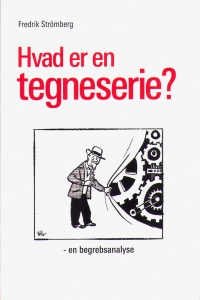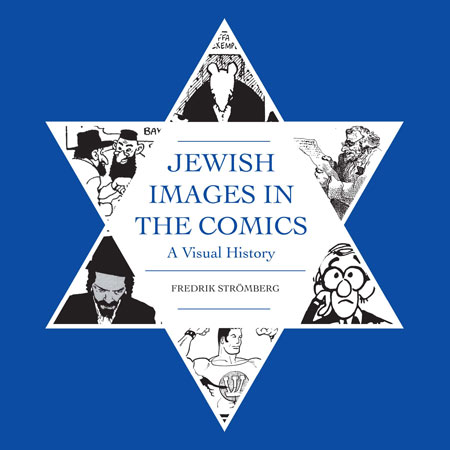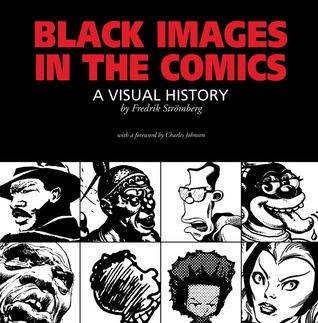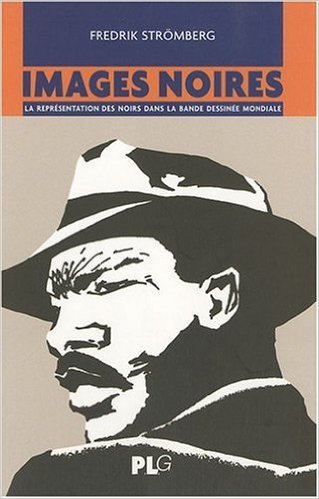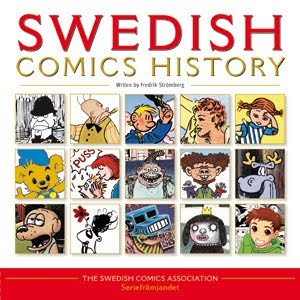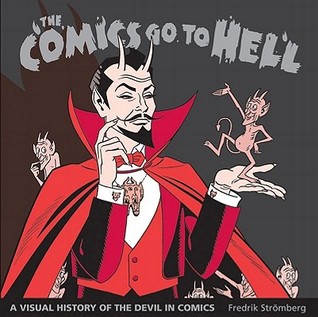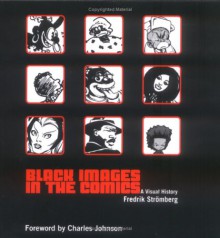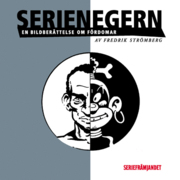Books
Writing books is one of the things that I love the most, and so far I’ve written about a dozen, which have been published around the world. They are presented below, but I have also produced a number of sketchbooks and yearbooks for the Comic Art School and written for various anthologies and encyclopaedias.
Serier i skolan – en lärarhandledning (2016)

- Title: Comics in the Classroom – A Teacher’s Guide
- Publisher: Seriefrämjandet/The Swedish Comics Association, Malmö, Sweden
- Format: 160 x 240 mm
- Content: 36 pages, color
- Language: Swedish
- ISBN: 978-91-86667-62-7
Official description: Comics is a fascinating, engaging and complex art form, well suited for use in classrooms – on many different levels. But what can you do as a teacher, where could you start and what materials could you use? In recent years, as comics have become increasingly accepted as part of educational activities, a number of practically oriented tutorials have been written on how to teach the making of comics. However, there has been a lack of a more comprehensive overview of how to get the most out of the art form of comics in the classroom. This is why the Swedish Comics Association has produced this guide.
Comment: This is merely a small pamphlet, but one that I put quite some time and effort into. It’s available for download here, and meant to be printed and used by anyone in need of some inspiration when it comes to using comics in a classroom situation. Sadly, it’s so far only available in Swedish.
Histoire de la bande dessinée suédoise (2015)
- Title: The History of Swedish Comics
- Publisher: PLG, Paris, France
- Format: 160 x 240 mm
- Content: 200 pages, b&w with color insert
- Language: French
- Cover: Bovil (Bo Vilson)
- ISBN: 978-2-917837-20-7
Official description: The publication of Histoire de la bande dessinée suédoise (The History of the Swedish Comics) in French is an attempt to respond to the collateral damage of the supremacy of a minority in a global medium. Scholars and historians have in fact too often summarize the history of comics through the countries that have produced the most comics: the United States, Japan, France and Belgium. The temptation is to consider that others only translated comics from these four countries, or imitated their styles and genres for exclusively local production. This is of course untrue …
Comment: French edition of the English language Swedish Comics History from 2010. The designer chose a beautiful image by the Swedish artist Bovil for the cover.
Seriebiblioteket (2014)
- Title: The Comics Library
- Publisher: BTJ, Lund, Sweden
- Format: 240 x 180 mm, softcover
- Content: 272 pages, b&w
- Language: Swedish
- Cover: Nina Hemmingsson
- ISBN: 978-9170187711
Official description: Seriebiblioteket (The Comics Library) is an overview of graphic novels published in Sweden, a combination of the reference book and source of inspiration for all who want to know more about this exciting art form. The book is divided into themes so that the reader can easily find new interesting reading experiences. Each book is presented in detail, with information about its creator, suggestions for further reading and much more. Whether you are an experienced comics readers or have recently discovered the fascinating world of comics, this is a book that can guide you in the wide range available today.
Comment: An extended and revised edition of the 2005 book with the same title, with new texts about comics at libraries by Ola Hellsten and Mats Nordström. Oh, and a beautiful cover by one of my favourite artists, Nina Hemmingsson.
Reviews:
- Seriebiblioteket av Fredrik Strömberg (Seriebibliotekarien, August 18, 2014)
- Seriebilioteket (Lektörsomdöme, BTJ, 2014)
Serier och öl – kultur för folket (2014)
- Title: Comics and Beer – Culture for the People
- Publisher: Seriefrämjandet/The Swedish Comics Association, Malmö, Sweden
- Format: 222 x 222 mm, softcover
- Content: 24 pages, b&w
- Language: Swedish
- Cover: Peter Madsen
- ISBN : 978-9186667399
Official description: This is an off-print from the magazine Bild & Bubbla number three 2014, with a presentation of some of the most interesting examples of comic featuring beer.
Comment: Just a small pamphlet, but it combines two of my main interests in life, beer and comics. Someday I would love to do a more thorough treatise on this subject.
Hvad er en tegneserie? – en begrebsanalyse (2013)
- Title: What are Comics? – An Analysis of a Concept
- Publisher: Damgaard, Aarhus, Denmark
- Format: 140 x 210 mm, softcover
- Content: 140 pages, b&w
- Language: Danish
- Cover: Thomas Nøhr
- ISBN : 978-8799485758
Official description: Hvad er en tegneserie? provides an overview of what leading comic researchers through the ages have written about the definition of the comic as a concept. The book examines hereinafter the different ways to define a concept and draws correlation between the defining writers’ motives and their conclusions. At the end of the book the author gives his own idea of how the concept of comics can be defined.
For the first time in Danish comics researchers, creators and readers thus get an understandable, yet thorough book, which can form the basis for further discussions and studies of comics.
Comment: A Danish edition of my Swedish book Vad är teckande serier? – en begreppanalays from 2003, with a beautiful new cover illustration by Thomas Nøhr.
Jewish Images in the Comics – A Visual History (2012)
- Publisher: Fantagraphic, Seattle, US
- Format: 155 x 155 mm, hardcover
- Content: 424 pages, b&w
- Language: English
- ISBN : 978-1-60699-528-0
Official description: Jewish Images in the Comics showcases more than 150 comic strips, comic books and graphic novels from all over the world, stretching over the last five centuries and featuring Jewish characters and Jewish themes.
The book is divided into chapters on Anti-Semitism, the Old Testament, the Holocaust, Israel, the Golem and much more, featuring everything from well-known comics like Art Spiegelman’s Maus and the work of Will Eisner to much more obscure (and in some cases far less savory) but no less culturally and historically interesting examples of how Jewish culture has been depicted in comics.
As with Strömberg’s previous two books for Fantagraphics, each strip, comic, or graphic novel is spotlighted via a short but informative 200-word essay and a representative illustration. The book is augmented by a context-setting introduction as well as an extensive source list and bibliography.
Comment: Sadly, the last book I got to do with my all-time favourite editor, Kim Thompson, before he passed away less than a year later. I still miss him.
Black Images in the Comics – A Visual History (2012)
- Publisher: Fantagraphics, Seattle, US
- Format: 150 x 150 mm, softcover
- Content: 304 pages, b&w
- Language: English
- ISBN: 978-1-60699-562-4
Official description: This book spotlights over 100 comic strips, comic books, and graphic novels to feature black characters from all over the world over the last century, and the result is a fascinating journey to, if not enlightenment, then at least away from the horrendous caricatures of yore.
The book begins with the habitually appalling images of blacks as ignorant “coons” in the earliest syndicated strips (Happy Hooligan, Moon Mullins, and The Katzenjammer Kids); continues with the almost-quaint colonialist images of the often-suppressed Tintin album Tintin in the Congo and such ambiguous figures as Mandrake the Magician’s “noble savage” assistant Lothar in the ’30s (not to mention Torchy Brown, the first syndicated black character), moving on to such oddities as the offensive Ebony character in Will Eisner’s otherwise classic The Spirit from the ’40s and ’50s.
We then continue into the often earnest attempts at ’60s integration in such strips as Peanuts (and comic books such as the Fantastic Four), as well as the first wave of “black strips” like Wee Pals, juxtaposed with the shocking satire of underground comics such as R. Crumb’s incendiary Angefood McSpade. Also investigated is the increased use of blacks in super-hero comic books as well as syndicated strips. Black Images in the Comics wraps up from the ’80s to now, with the increased visibility of blacks, often in works actually produced by blacks, all the way to the South African strip Madam & Eve, Aaron McGruder’s pointed daily The Boondocks, and more — including over a dozen new entries added to the out-of-print hardcover edition.
Each strip, comic, or graphic novel is spotlighted via a compact but instructive 200-word essay and a representative illustration. The book is augmented by a context-setting introduction, an extensive source list and bibliography, and a foreword by Charles R. Johnson, the recipient of a MacArthur Foundation fellowship and winner of the National Book Award for his 1990 novel Middle Passage.
Comment: An extended softcover edition of this book, where I added many of the new comics that I had added in the French and Danish versions, but also other interesting examples of comics that had been published since the previous English language edition from 2003.
La Propagande dans la BD – Un siècle de manipulation en images (2010)
- Title: Propaganda in Comics – A Century of Manipulation though Images
- Publisher: Les Éditions Eyroles, Paris, France
- Format: 215 x 242 mm, hardcover
- Content: 176 pages, colour
- Language: English
- ISBN: 978-2212127195
Official description: Like any media, comics reflects their time. Like any media, comics is capable of the best and the worst. But more than any other media, comics are popular, it has the power to convince and fascinate by its very nature, particularly a young audience with an uncritical willingness to accept all kinds of views.
No wonder then that those who run the world have used comics to their advantage: and people have been convinced that black children were funny, Jews traitors and manipulators, superheroes could kick Hitler’s ass and other kinds of “truths”: comic are the cause of juvenile delinquency, war is fun and safe, marijuana makes you inevitably crazy and abortion leads to eternal damnation …
This book offers the reader a journey through time and space, of the last century to the present, from the United States, to Europe via China, Japan or Cuba … Dealing with racism and xenophobia, but also politics, religion, social issues, La Propaganda dans la BD is a compelling story about some of the most controversial, outrageous, atypical and engaging comics ever published.
Comment: The French edition of Comic art Propaganda; a straight translation with no new material.
Image Noires – La représentation des Noirs dans la bande dessinée mondiale (2010)
- Title: Black Images – The representation of Black People in Comics Worldwide
- Publisher: PLG, Paris, France
- Format: 170 x 240 mm, softcover
- Content: 176 pages, b&w
- Language: French
- Cover: Ho Che Anderson
- ISBN: 978-2-917837-03-0
Official description: Negro. Black. Colored. African American. When a foreign national or a local minority is mentioned, words are so overused they can only be used with caution to avoid any implied insult. The author examines how mostly white people have represented black people in the world of comics since the birth of the media and shows the implications of this. Only by identifying, investigating and denouncing racism of the past can we denounce and combat today’s racism.
Comment: The French edition of Black Images in the Comics from 2003, with about ten new examples of French/Belgian comics.
Comic Art Propaganda – a Graphic History (2010)
- Publisher: Ilex Press (UK) & St. Martin’s Griffin (US)
- Format: 224 x 249 mm, hardcover and softcover
- Content: 176 pages, color
- Language: English
- Foreword: Peter Kuper
- ISBN: 978-1905814701, 978-0312596798
Official Description: As one of the most effective and powerful forms of communication, it comes as no surprise that comic art has been misappropriated by governments, self-interest groups, do-gooders, and sinister organizations to spread their message. World War II comic book propaganda-with Superman, Batman, and Captain America raising war bonds, and bashing cartoon Japanese and Germans-was so ubiquitous that there was barely a US comic untainted by the war effort. The sub-textual sequential art continued well into the Ciold War, with both sides producing comics extolling themselves and defaming the enemy. This book is a fascinating visual history of some of the most outrageous, and unbelievable and politically charged comics ever published.
Comment: This book was published simultaneously in Great Britain and the US, by Ilex and St. Martin’s Griffin respectively. Oh, and it contains a beautiful foreword by the great Peter Kuper, partly in the comics form.
Reviews:
“Comic Art Propaganda” by Fredrik Strömberg (Science Leadership Academy, November 5, 2014)
Swedish Comics History (2010)
- Publisher: Seriefrämjandet/The Swedish Comics Association, Malmö, Sweden
- Format: 225 x 225 mm, softcover
- Content: 120 pages, color
- Language: English
- ISBN: 978-9185161775
Official description: This book contains a short history of comics in Sweden, with focus on the visual parts: the images. Swedish comics are just now about to make it abroad, but they have a long and intricate history – going back to (at least) the end of the 18th century. Perhaps even more interesting is the fact that today, comics artists of Sweden display a variety of expressions and breadth of subject matter unequalled in the history of this country. Welcome to a journey into an unknown territory.
“You could find no better guide to the fascinating heritage and contemporary dynamism of strips, comics, graphic novels and even manga from Sweden than Fredrik Strömberg. His passionate curiosity and in-depth research make this a hugely enjoyable voyage of discovery.” /Paul Gravett, author of Manga – Sixty Years of Japanese Comics and Great British Comics – A Century of Ripping Yarns and Wizard Wheezes.
Comment: This is a new, revised and heavily expanded version of the book Swedish Comics History from 2003, which was created for the event Swedish Invasion at MoCCA in New York, where Top Shelf released as number of translated Swedish graphic novels.
Reviews:
Grunnleggende om svenske tegneeserier (Serienet, May 20, 2016)
Mangabiblioteket – introduktion till den asiatiska seriekulturen (2008)
- Title: The Manga Library
- Publisher: BTJ, Lund, Sweden
- Format: 130 x 200 mm, softcover
- Content: 227 pages, b&w
- Languge: Swedish
- ISBN: 978-91-7018-625-7
Official description: A guide for those who want to understand the new and exciting culture of Asian comics. The book presents a variety of comics, detailing both basic information and a brief resume of the content, as well as indicating recommended age group, comments about the specific features of each comic, hint about further reading etc.
Comment: A book made in the same format as Seriebiblioteket (2005), but specifically about Asian comics published in Sweden. Some of the content went into the new edition of Seriebiblioteket, from 2014.
Manga! Japanska serier och skaparglädje (2007)
- Title: Manga! Japanese Comics and the Joy of Creating
- Publisher: Seriefrämjandet/The Swedish Comics Association, Malmö, Sweden
- Format: 145 x 175 mm, softcover
- Content: 220 pages, b&w
- Language: Swedish
- Cover: Gert Lozell
- ISBN: 978-9185161287
Official description: Manga! Manga! Everyone seems to be talking about manga!
Manga, ie Japanese comics, was just a few years ago, something only fans knew about. But now this trend has conquered most of the western world, has also become big in Sweden.
There are currently in a number of courses in drawing manga in Sweden, and a wide range of instructional books on how to draw in “manga style”. The Swedish manga publications are furthermore filled with the readers’ own drawings. All this gives the impression that there is something in the Japanese comics culture, urging the reader to take up pen and paper.
In this book, Fredrik Strömberg investigate this creativity, its causes, and not least the educational opportunities it can offer.
Comment: This was an essay written at Malmö University at the hight of the manga craze in Sweden, which I made into a small book. Among the research I did was a roundtable with first generation manga fans in Sweden, and field studies of courses in drawing manga for young kids.
The Comics Go to Hell – A Visual History(2005)
- Publisher: Fantagraphics, Seattle, US
- Format: 158 x 158 mm, hardcover
- Content: 360 pages, b&w
- Language: English
- Cover: Jaime Hernandez
- ISBN: 978-1-56097-616-0
Official description: The Devil is one of the most potent and longest-lived icons in the history of human civilization. It is therefore not a big surprise that images of the Prince of Darkness are so abundant in comics — a medium that by its nature builds upon the communicative powers of icons. In this book, author Fredrik Strömberg examines how cartoonists through the ages have used the myths about the Devil, in a wide variety of ways. Comics featured in this book include, among others: the infamous Jack T. Chick tracts, Hellblazer, Love & Rockets, The Checkered Demon, Donald Duck, Mephisto, Dilbert, The New Adventures of Jesus, Stray Toasters, The Demon, Futurama, Preacher, Hot Stuff – The Little Devil, Castle Waiting, Sandman, The Book of Leviathan, Swamp Thing, Dragon Ball, Spawn, Silver Surfer, Picture Stories from the Bible, Uncanny X-Men, Tintin, Sshhhh!, and Lady Death. Like Strömberg’s previous book from Fantagraphics, Black Images in the Comics, this book is designed for maximum browsability, with each spread featuring a short (but informative!) essay on a comic next to a representative panel of the work at hand. With an original cover illustration by Jaime Hernandez!
Comment: The second volume in the series of books in which i study phenomenon in our society seen though comics, written directly in English for Fantagraphics.
Seriebiblioteket (2005)
- Title: The Comics Library
- Publisher: BTJ; Lund, Sweden
- Format: 240 x 170 mm, softcover
- Content: 233 pages, b&w
- Language: Swedish
- Foreword: Kristiina Kolehmainen & Mats Nordström
- Cover: Niklas Asker
- ISBN: 978-9170185397
Official description: Seriebiblioteket (The Comics Library) is a combination of the reference tool and source of inspiration for all who want to know more about comics.
About 150 high quality graphic novels, all published in Swedish, are presented in detail sorted into different themes: from Avantgarde, Mystery/Thrillers and Humor to Relationships, SF/Fantasy and Adventure/Action – today’s choice of comics is wide and varied and caters for all ages. Manga and the new Asian comics are also discussed in detail.
The book begins with three chapters that show different ways of working with comics in libraries and in other educational activities. Authors of the article are Kristiina Kolehmainen, Head of Serieteket, Sweden’s only special library for comics and Mats Nordström, head of the department of comics at Malmö City Library.
Seriebiblioteket is written for librarians, teachers, and others who wish to orient themselves in the exciting world comics, and a more knowledgeable cicerone than Fredrik Strömberg you can hardly find.
Comment: A revised and heavily updated version of the book 100 oumbärliga seriealbum from 1999, actually a whole new book – thus the new title. Most noticeable, I changed the book from being sorted alphabetically to being sorted in different genres, chosen with Serieteket’s own Kristiina Kolehmainen.
Black Images in the Comics – A Visual History (2003)
- Publisher: Fantagraphics, Seattle, US
- Format: 158 x 158 mm, hardcover
- Content: 160 pages, b&w
- Language: English
- ISBN: 978-1560975465
Official description: This wide-ranging little book spotlights over 100 comics strips, comic books, and graphic novels to feature black characters from all over the world over the last century, and the result is a fascinating journey to, if not enlightenment, then at least away from the horrendous caricatures of yore.
The book begins with the habitually appalling images of blacks as ignorant “coons” in the earliest syndicated strips (Happy Hooligan, Moon Mullins, and The Katzenjammer Kids); continues with the almost-quaint colonialist images of the suppressed Tintin album Tintin in the Congo and such ambiguous figures as Mandrake the Magician’s “noble savage” assistant Lothar in the ’30s (not to mention Torchy Brown, the first syndicated black character), moving on to such oddities as the offensive Ebony character in Will Eisner’s otherwise classic The Spirit from the ’40s and ’50s. We then continue into the often earnest attempts at ’60s integration in such strips as Peanuts (and comic books such as the Fantastic Four), as well as the first wave of “black strips” like Wee Pals, juxtaposed with the shocking satire of underground comics such as R. Crumb’s incendiary Angefood McSpade. Also investigated is the increased use of blacks in super-hero comic books such as Uncanny X-Menand Luke Cage, Hero for Hire, as well as syndicated strips like Friday Fosterand Quincy in the ’70s (to say nothing of Beetle Bailey‘s controversial Lt. Flap). From Cartoon Coons to the Boondocks wraps up from the ’80s to now, with the increased visibility of blacks, often in works actually produced by blacks, all the way to the South African strip Madam & Eve, Aaron McGruder’s pointed daily The Boondocks, and Ho Che Anderson’s Martin Luther King biography King.
Each strip, comic, or graphic novel is spotlighted via a compact but instructive 200-word essay and a representative illustration. The book is augmented by a context-setting introduction, an extensive source list and bibliography, and a foreword by Charles R. Johnson, the recipient of a MacArthur Foundation fellowship and winner of the National Book Award for his 1990 novel Middle Passage (and a published cartoonist to boot!).
Comment: A heavily extended and rewritten version of the Swedish language book Serienegern, and my first book for Fantagraphics. Nominated for an Eisner Award for best book about comics.
Vad är tecknade serier? En begreppsanalys (2003)
- Title: What are Comics? – An Analysis of a Concept
- Publisher: Seriefrämjandet/The Swedish Comics Association, Malmö, Sweden
- Format: 145 x 175 mm, softcover
- Content: 162 pages, b&w
- Language: Swedish
- Cover: Jerry Dumas
- ISBN: 978-9197444033
Official Description: How do you define the term “comics”? It may sound simple – almost obvious – but on reflection it is actually very difficult. The author Fredrik Strömberg in this book go through and analyze many of the attempts that have been made over the past 150 years, both in Sweden and abroad, to establish what comics really are – and will end with its own contribution to this ongoing debate. A basic book for anyone seriously thinking about comics.
Comment: This was initially an essay written at Malmö University, which I turned into a book.
Swedish Comics History (2003)
- Publisher: Seriefrämjandet/The Swedish Comics Association, Malmö, Sweden
- Format: 145 x 175 mm, softcover
- Content: 84 pages, b&w
- Language: English
- ISBN: 978-9197444088
Official description: Swedish Comics history extends far back in time, and has over the years taken many and varied expressions. This is a short but well illustrated overview of this history – from rune stones to Rocky. The author and comic historian Fredrik Strömberg reflect on trends and traditions and showcases many examples of how wide and varied the Swedish comics culture is and has been. The book is written in English as it is intended for the international market, but is of course interesting for all who want to get an overview of the Swedish comics history.
Comment: This book originated in an article I wrote for International Journal of Comic Art (IJoCA) a few years earlier. I realised that there weren’t any general book on Swedish comics, and more importantly, almost nothing on the subject in English.
Serienegern – en bildberättelse om fördomar (2001)
- Title: The Comics Negro – A Visual Story of Prejudice
- Publisher: Seriefrämjandet/The Swedish Comics Association, Malmö, Sweden
- Format: 140 x 140 mm, softcover
- Content: 160 pages, b&w
- Language: Swedish
- Cover: Patrik Norrman
- ISBN: 978-9197443951
Official Description: Negro, are you allowed to say that? Yes, if you as the author of this book, aim at shining a light at such an infected subject as racism and its history, you must not swerve from using uncomfortable terms. This is a book about how people of color have been represented in comics. The book ranges over more than a hundred years as we follow the development from explicit racist images to the more nuanced pictures of today.
Comment: This book started as a suggestion for a lecture, which I willingly accepted and then realised, while doing my research, that there strangely was almost no viable texts on the subject. To date, it has, though various extensions and translations been my most successful and popular book.
100 oumbärliga seriealbum – en presentation av de bästa seriealbumen på svenska (1999)
- Title: 100 Indispensable Graphic Novels – A Presentation of the Best Graphic Novels in Swedish
- Publisher: BTJ, Lund, Sweden
- Format: 240 x 170 mm, softcover
- Content: 163 pages, b&w
- Language: Swedish
- Preface: Barbro Stenflo
- Cover: Mats Källblad
- ISBN: 978- 91-7018-443-7
Official Description: A presentation of the one hundred best graphic novels available in Swedish. Here you will find everything from comics for smaller children to purify adult comics, from seemingly simple humor comics to serious treatises on the horrors of war, from realistically drawn adventures to abstract comics experiences.
Comment: My very first book, done after a request from the publisher. I had worked as a journalist for a few years, but writing a whole book was a dunting task. for the selection, I put together a very knowledgeable panel which helped a lot. This book has been extended and rewritten twice, under the new title Seriebiblioteket.
